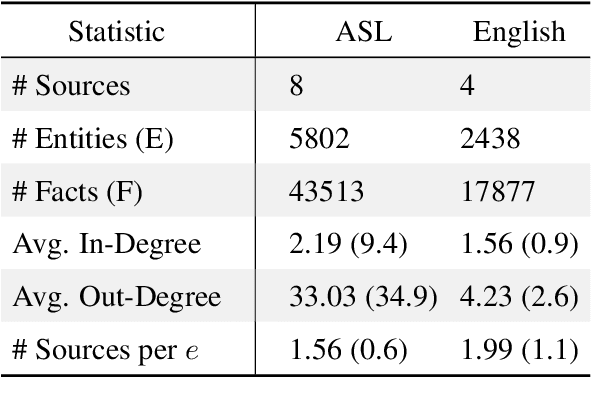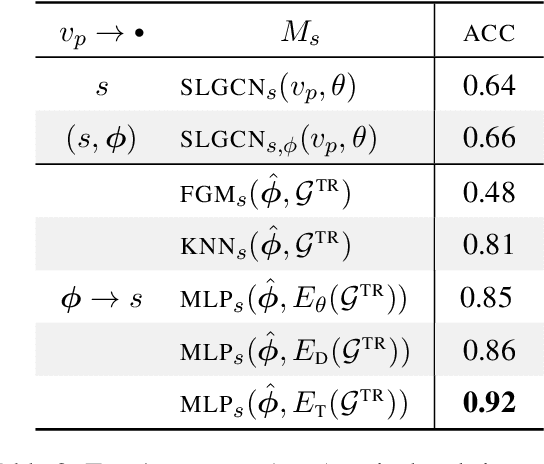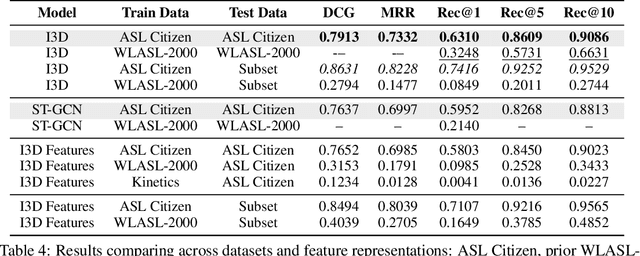Naomi Caselli
The American Sign Language Knowledge Graph: Infusing ASL Models with Linguistic Knowledge
Nov 06, 2024



Abstract:Language models for American Sign Language (ASL) could make language technologies substantially more accessible to those who sign. To train models on tasks such as isolated sign recognition (ISR) and ASL-to-English translation, datasets provide annotated video examples of ASL signs. To facilitate the generalizability and explainability of these models, we introduce the American Sign Language Knowledge Graph (ASLKG), compiled from twelve sources of expert linguistic knowledge. We use the ASLKG to train neuro-symbolic models for 3 ASL understanding tasks, achieving accuracies of 91% on ISR, 14% for predicting the semantic features of unseen signs, and 36% for classifying the topic of Youtube-ASL videos.
The Sem-Lex Benchmark: Modeling ASL Signs and Their Phonemes
Sep 30, 2023Abstract:Sign language recognition and translation technologies have the potential to increase access and inclusion of deaf signing communities, but research progress is bottlenecked by a lack of representative data. We introduce a new resource for American Sign Language (ASL) modeling, the Sem-Lex Benchmark. The Benchmark is the current largest of its kind, consisting of over 84k videos of isolated sign productions from deaf ASL signers who gave informed consent and received compensation. Human experts aligned these videos with other sign language resources including ASL-LEX, SignBank, and ASL Citizen, enabling useful expansions for sign and phonological feature recognition. We present a suite of experiments which make use of the linguistic information in ASL-LEX, evaluating the practicality and fairness of the Sem-Lex Benchmark for isolated sign recognition (ISR). We use an SL-GCN model to show that the phonological features are recognizable with 85% accuracy, and that they are effective as an auxiliary target to ISR. Learning to recognize phonological features alongside gloss results in a 6% improvement for few-shot ISR accuracy and a 2% improvement for ISR accuracy overall. Instructions for downloading the data can be found at https://github.com/leekezar/SemLex.
Exploring Strategies for Modeling Sign Language Phonology
Sep 30, 2023


Abstract:Like speech, signs are composed of discrete, recombinable features called phonemes. Prior work shows that models which can recognize phonemes are better at sign recognition, motivating deeper exploration into strategies for modeling sign language phonemes. In this work, we learn graph convolution networks to recognize the sixteen phoneme "types" found in ASL-LEX 2.0. Specifically, we explore how learning strategies like multi-task and curriculum learning can leverage mutually useful information between phoneme types to facilitate better modeling of sign language phonemes. Results on the Sem-Lex Benchmark show that curriculum learning yields an average accuracy of 87% across all phoneme types, outperforming fine-tuning and multi-task strategies for most phoneme types.
ASL Citizen: A Community-Sourced Dataset for Advancing Isolated Sign Language Recognition
Apr 12, 2023



Abstract:Sign languages are used as a primary language by approximately 70 million D/deaf people world-wide. However, most communication technologies operate in spoken and written languages, creating inequities in access. To help tackle this problem, we release ASL Citizen, the largest Isolated Sign Language Recognition (ISLR) dataset to date, collected with consent and containing 83,912 videos for 2,731 distinct signs filmed by 52 signers in a variety of environments. We propose that this dataset be used for sign language dictionary retrieval for American Sign Language (ASL), where a user demonstrates a sign to their own webcam with the aim of retrieving matching signs from a dictionary. We show that training supervised machine learning classifiers with our dataset greatly advances the state-of-the-art on metrics relevant for dictionary retrieval, achieving, for instance, 62% accuracy and a recall-at-10 of 90%, evaluated entirely on videos of users who are not present in the training or validation sets. An accessible PDF of this article is available at https://aashakadesai.github.io/research/ASL_Dataset__arxiv_.pdf
Sign Language Recognition, Generation, and Translation: An Interdisciplinary Perspective
Aug 22, 2019

Abstract:Developing successful sign language recognition, generation, and translation systems requires expertise in a wide range of fields, including computer vision, computer graphics, natural language processing, human-computer interaction, linguistics, and Deaf culture. Despite the need for deep interdisciplinary knowledge, existing research occurs in separate disciplinary silos, and tackles separate portions of the sign language processing pipeline. This leads to three key questions: 1) What does an interdisciplinary view of the current landscape reveal? 2) What are the biggest challenges facing the field? and 3) What are the calls to action for people working in the field? To help answer these questions, we brought together a diverse group of experts for a two-day workshop. This paper presents the results of that interdisciplinary workshop, providing key background that is often overlooked by computer scientists, a review of the state-of-the-art, a set of pressing challenges, and a call to action for the research community.
 Add to Chrome
Add to Chrome Add to Firefox
Add to Firefox Add to Edge
Add to Edge